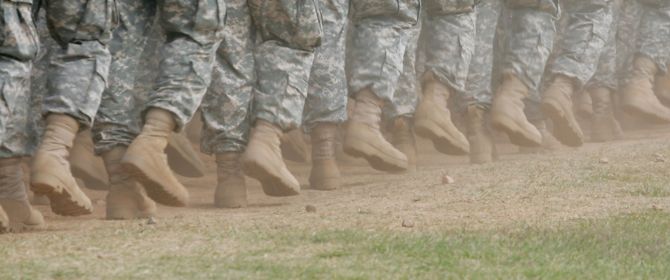Around the world, extreme weather is causing damage and instability that requires military assistance.
This is happening both in-country and overseas. Earlier this year, the National Guard was mobilized to battle the US state of New Mexico’s largest ever wildfire1, while in 2018, more than 2000 UK troops assisted relief efforts following several devastating hurricanes in the Caribbean.2
Global warming also increases the potential for civil unrest. The Arab Spring uprisings and the subsequent war in Syria are attributed in part to food shortages brought on by droughts in China, Russia and Ukraine and by unseasonable rain in Canada and Australia.
As the severity and frequency of climate-related events increases, we can expect further volatility as well as competition for scarce materials such as water, minerals and fossil fuel rights, all of which can sow the seeds of conflict.
For defense forces, climate change represents a clear "threat multiplier" and should be incorporated into future defense strategies.
Adapt and prevent
Defense has a responsibility to adapt to a climate changed world and contribute to efforts to mitigate global warming and create a more sustainable and resilient future.
Adapt
Future fighting forces will exist in a world where climate change can influence how and where they are deployed, the type of tasks they undertake, and the conditions in which they operate.
Their duties include dealing with the second-order effects of climate change, like mass migration from uninhabitable geographies, as well as food supply disruption due to crop failures. In the US, Executive Order 14013 acknowledges the need for resettlement planning for displaced persons and refugees.3
Climate change can also pose a direct physical risk to defense forces and their facilities, as evidenced by 2018’s Hurricane Michael, which caused around US$4 billion of damage to Tyndall Air Force Base, Florida.4 Similarly, a warmer climate can degrade capabilities such as reduced air lift in hot, less dense air.5
On the battlefield, armies should be capable of operating in adverse weather conditions, with sustainable - ideally self-sustaining - supply lines.
Mitigate
Defense has a significant carbon and environmental impact. The UK Ministry of Defense (MOD), for example, accounts for half of central government’s greenhouse gas emissions, two-thirds of water use and 56 percent of waste.6
The defense footprint also extends into many parts of industry via major defense manufacturers at home and abroad, increasing these companies’ indirect carbon emissions, use of scarce resources and pollution.
Curbing these impacts is a significant challenge, given that defense involves sectors with some of the toughest decarbonization challenges — notably aviation and maritime — as well as ageing, energy-inefficient estates.
Doing nothing is not an option. A failure to decarbonize could leave defense budgets highly exposed to carbon taxes and reliant on fossil fuels, which may become increasingly expensive as the world transitions to alternative energy sources. This could impair the ability to invest in key capabilities.
Furthermore, by not acting against climate change, defense risks losing its "social license" and influence, while also having to rely on outdated technologies and miss out on opportunities presented by the energy transition. For example, fighting units supported by energy and water-efficient assets and distributed energy generation need lower logistical support and are less vulnerable to fuel and other supply shortages. Electric vehicles are becoming more cost-effective and reliable and offer performance improvement over conventionally powered vehicles.7
By seizing the benefits of new, more sustainable, technologies, militaries can benefit both financially and competitively.
Prioritizing a climate change response
There is a rising awareness of the impact of climate change on defense force effectiveness and of the need to act.
Given the scale of the task, and the competing demands of defense activity any action should be ranked in terms of impact. Robust analyses of the major physical and transitional risks facing defense departments, based on the impacts of possible future climate scenarios, can identify where climate change is likely to hit hardest. Although complex, such an approach is being adopted throughout the private sector and can be delivered at pace via predictive analytics.
Considering the multiple competing interests for defense, these risks and opportunities may not always appear to be high priority, but this should not be a reason for opting out of the climate change debate.
In a world increasingly affected by extreme weather and rising sea levels, defense organizations should meet the demands of allies, governments and citizens, and match or exceed the response of adversaries. The right actions will result in a more effective defense capability and help to slow down global warming.
Throughout this page, “we”, “KPMG”, “us” and “our” refers to the global organization or to one or more of the member firms of KPMG International Limited (“KPMG International”), each of which is a separate legal entity.
Connect with us
- Find office locations kpmg.findOfficeLocations
- kpmg.emailUs
- Social media @ KPMG kpmg.socialMedia
Related content
1 https://www.army.mil/article/257080/fighting_wildfires_almost_year_round_guard_preps_for_more
2 https://www.itv.com/news/2018-11-24/uk-troops-recognised-for-relief-work-after-caribbean-hurricanes
3 https://www.whitehouse.gov/briefing-room/presidential-actions/2021/02/04/executive-order-on-rebuilding-and-enhancing-programs-to-resettle-refugees-and-planning-for-the-impact-of-climate-change-on-migration/
4 https://www.defense.gov/News/News-Stories/Article/Article/2642717/combating-climate-change-factors-into-defense-budget-request/
5 https://www.forbes.com/sites/jimfoerster/2020/08/21/helicopter-operators-face-a-summer-of-risks/
6 https://www.nao.org.uk/wp-content/uploads/2020/05/Environmental-Sustainability-Overview.pdf
7 https://www.army.mod.uk/news-and-events/news/2021/07/army-hybrid-vehicles-power-forward/


